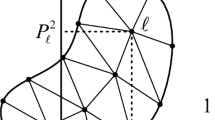Abstract
Compliant mechanisms with embedded direct-driven actuators are gaining a wide interest in manufacturing systems as well as structural systems. In this paper, we present a procedure for motion analysis of a compliant mechanism which is driven by three embedded piezoelectric actuators with a general-purpose finite element system, in particular, ANSYS. This includes finite element modeling of the piezoelectric actuator and finite element modeling of the compliant mechanism. An experimental validation was conducted, which shows that the model is highly accurate. The contribution of this paper is a novel application of finite element methods with multidisciplinary elements to motion and stress analysis of compliant mechanisms with embedded piezoelectric actuators. In the current literature, for a complaint mechanism, either the piezoelectric actuator is modeled with absence of piezoelectric effects or a pseudo rigid body approach is applied with poor accuracy. Another contribution lies in the use of a general-purpose finite element software system, which will greatly increase the generalization of finite element modeling applications.
Similar content being viewed by others
References
Abdalla MM, Frecker M, Gurdal Z, Johnson T, Lindner DK (2003) Maximum energy-efficiency compliant mechanism design for piezoelectric stack actuators. Am Soc Mech Eng Aerosp Div (Publ) AD 68:53–61
Alik H, Hughes TJR (1970) Finite element method for piezoelectric vibration. Int J Numer Methods Eng 2:151–157
Angelino MR, Washington GN (2002) Design and construction of a piezoelectric point actuated active aperture antenna. J Intell Mater Syst Struct 13:125–136
ANSYS (2004) ANSYS Release 8.1 documentation preview, Swanson Analysis System, Inc., Houston
Bharti S, Frecker MI (2004) “Optimal design and experimental characterization of a compliant mechanism piezoelectric actuator for inertially stabilized rifle’. J Intell Mater Syst Struct 15:93–106
Cattafesta,L., Mathew,J., and Kurdila,A, 2000. “Modeling and design of piezoelectric actuators for fluid flow control (online posting)’, SAE International and AIAA, Inc. http://www.img.ufl.edu/publications/Modeling%20and%20Design%20of%20Piezoelectric%20Actuators%20for%20Fluid%20Control_Conference_October2000.pdf
Chen W, Lin W (2003) A miniature gripper system for optical fiber handling. Proc SPIE Int Soc Opt Eng 4902:436–443
Handley DC, Zhao W, Zhang W J, Li Q and Lu Tien-Fu (2002) “An experimental observation of uncoupling of multi-DOF PZT actuators in a compliant mechanism”, Proceedings of the 7th International Conference on Control, Automation, Robotics and Vision, ICARCV 2002, 1, pp. 1354-1358
Hara A, Sugimoto K (1989) Synthesis of parallel micromanipulators. ASME Trans J Mech Transm Autom Des 111:34–39
Her I, Chang JC (1994) A linear scheme for the displacement analysis of micropositioning stages with flexure hinges. ASME Trans J Mech Des 116:770–776
Kim J, Ko B, Lee J-K, Cheong C-C (1999) Finite element modeling of a piezoelectric smart structure for the cabin noise problem. Smart Mater Struct 8:380–389
Lee KM, Arjunan S (1989) A three-degrees-of-freedom micromotion in-parallel actuated manipulator. IEEE Trans Robot Autom 7(5):634–641
Li Q, Zhang WJ and Chen L, (2001) Design for control (DFC): a concurrent engineering approach for mechatronic system design, IEEE/ASME Trans on Mechatronics, June, 6(2), pp. 161-169. (cited by 29, 2009 by GS)
Peelamedu SM, Dukkipati RV, Naganathan NG (2001) “Finite element approach to model and analyze piezoelectric actuators”. JSME Int J, Series C: Mech Syst Mach Elem Manuf 44(2):476–485
Piefort V and Preumont A, (2001) “Finite element modeling of piezoelectric structures (on-line posting)”, Active Structure Laboratory, Belgium. <http://www.ulb.ac.be/scmero/documents/piezo/js2001_ulb_vp.pdf>
Ouyang P, Clement R, Zhang WJ and Yang GS (2008) Micro motion devices technology: the state of arts review. J Advanced Manuf Technol (Online: 17 July 2007; http://www.springerlink.com/content/j01055248rgm151t/), 38
Ouyang PR, Zhang WJ, Gupta MM, Zhao W (2007) Overview of the development of a visual based automated bio-micromanipulation system. Mechatronics 17(10):578–588
Von Preissig FJ and Kim ES (2000) “Topics in finite element modeling of piezoelectric MEMS (on-line posting)”, University of Hawaii and University of South Carolina, USA, 2000. <http://www.comppub.com/publications/MSM/2000/pdf/T45.09.pdf>
Tjiptoprodjo RC (2005) On a finite element approach to modeling of piezoelectric element driven compliant mechanism. University of Saskatchewan, Saskatoon
Zettl B (2003) Effective finite element modeling of micro-positioning systems. University of Saskatchewan, Saskatoon
Zhang WJ, Li Q, Guo SL (1999) Integrated design of mechanical structure and control algorithm for a programmable four-bar linkage. IEEE/ASME Trans on Mechatronics 4(4):354–362
Zhang WJ, Zou J, Watson G, Zhao W, Zong GH, Bi SS (2002) Constant-Jacobian method for kinematics of a 3-DOF planar micro-motion stage. J of Robotic Systems 19(2):63–79, April
Zou J (2000) Kinematics, dynamics, and control of a particular micro-motion system. University of Saskatchewan, Saskatoon
Author information
Authors and Affiliations
Corresponding author
Appendix
Appendix
Data of the piezoelectric actuators used in the RRR mechanism
For the matrices in the main body of text, i.e., Eqs. 10, 11, 12, 13, 14, and 15, the data of the particular piezoelectric actuators used in the RRR mechanism populated these matrices as follows (respectively):
Rights and permissions
About this article
Cite this article
Clement, R., Huang, J.L., Sun, Z.H. et al. Motion and stress analysis of direct-driven compliant mechanisms with general-purpose finite element software. Int J Adv Manuf Technol 65, 1409–1421 (2013). https://doi.org/10.1007/s00170-012-4266-1
Received:
Accepted:
Published:
Issue Date:
DOI: https://doi.org/10.1007/s00170-012-4266-1




